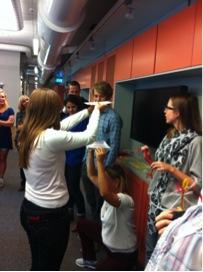2.4.1 Learning to be creative
When working on finding solutions to different kinds of challenges, the students will need to use their creativity. As stated by Robinson (16), creativity is something we need to learn:
“It is often said that education and training are the keys to the future. They are, but a key can be turned in two directions. Turn it one way and you lock resources away, even from those they belong to. Turn it the other way and you release resources and give people back to themselves. To realize our true creative potential—in our organizations, in our schools and in our communities—we need to think differently about ourselves and to act differently towards each other. We must learn to be creative."
There are a number of different exercises designed to improve creativity, also known as Idea Generating Methods, and examples are Brainstorming, Collective Notebook, Fishbone Technique, Metaphorical Thinking (17). Below, two methods are described in detail, the Rapid Prototype Exercise and an exercise inspired by Systems Engineering including Brainstorming.

One of the groups pitching their solution, OpenLab. Photo: Marie Magnell.
An Example from Open Lab of a learning activity on creativity:
The students in the course are introduced to the creative design process through an exercise called Rapid Prototyping. The exercise contains three steps and it is repeated to allow for all teams’ problems to be discussed and processed. The steps include:
1. The first team gives a very brief introduction to their problem/task, i.e. the task that the team is going to work on during the course (e.g. health care needs of older people).
2. All the teams then spend about five minutes to elaborate on a solution to the problem/task just presented. Each team presents one idea/solution, preferably not in text but by using other kinds of materials, e.g. paper, sticky tape, fabric, wire.
3. After five minutes, all groups reassemble and then present, pitch, their ”quick and dirty” prototype in maximum three minutes per team.
After the first pitch, the groups move on to the next teams’ problem/task and the process starts from scratch again. In total, with three student teams, and thereby three process iterations, about an hour was spent on the creativity process exercise.
For additional information on design thinking, see http://openlab.se/en/what-is-openlab/ , Stanford methods to improve design thinking practice: http://dschool.stanford.edu/use-our-methods/, and HPI School of Design Thinking: http://www.hpi.uni-potsdam.de/d_school/designthinking.html?L=1
An Example of a learning activity on creativity from Naval design/Lightweight design:
The students in previous course rounds used to have problems with the creative phase of the project. For the last few years , systems engineering have offred lectures and exercises in in an antecedent course. This is repeated and extended during the first four weeks of this course. This part of the course is called “First steps in your design process” and contains:
Week 1: The students have to formulate catchy mission statements and descriptions of needs and opportunities, stakeholders’ expectations, and a system concept. They will also produce associative and inspirational pictures and ideas for their projects based on brainstorming (see below).
Week 2: The students need to present measurable requirements and a functional architecture.
Week 3: In this stage, they present physical architectures for several design solutions.
Week 4: A final presentation of the work is made.
The change has been successful and the students are now more prepared e.g. to make sketches for the project and s identified requirements and stakeholders.
The basics of brainstorming:
- start individually and let the students think for themselves for a few minutes.
- go for quantity, try to get 100 ideas!
- encourage wild ideas; there are no right or wrong ideas.
- don’t critique or debate ideas.
- try to build on each idea, try to push or introduce small variation.
- be visual, include sketches, mind maps and diagrams.
- don’t go on for more than 45 min.
Brainstorming preparations:
- start with a well-defined statement of the problem.
- cover virtually every wall and flat surface with paper before the session.
- choose a facilitator who should focus on writing everything down and not ideate.
For additional ideas on brainstorming: www.me.umn.edu/courses/me2011/handouts/brainstorm.pdf
Suggestion: To ensure that students develop creative skills, introduce some kind of learning activity on creativity, preferably repeatedly rather than just on one occasion to make sure the students can make use of the method in their project work.